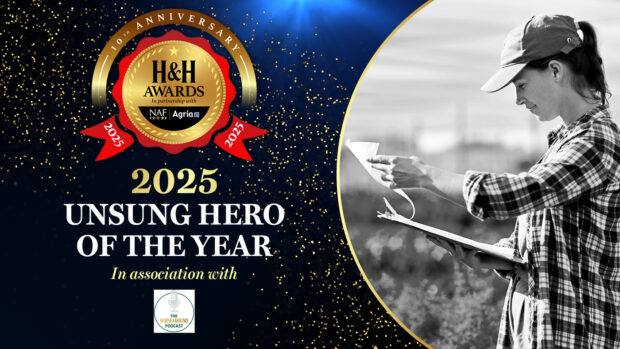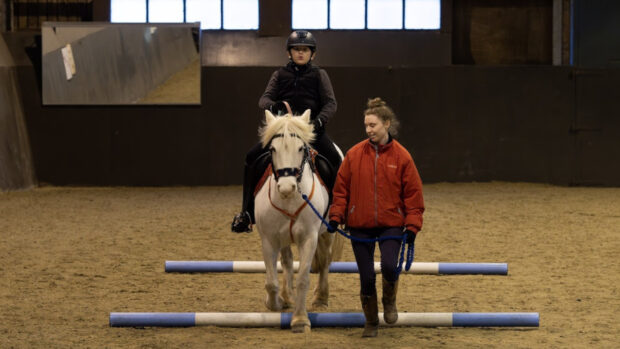Being safe and steady is a huge part of what makes a good therapy horse; an equine who is handled or ridden by someone with a physical or learning disability needs to be ultra-trustworthy. However, according to Emma Briggs, head of coaching at the Riding for the Disabled Association (RDA), this doesn’t mean a therapy equine is a one-size-fits-all stamp.
“People assume the RDA just does therapeutic riding – in reality, there’s so much more on offer,” she tells Horse & Hound. “We offer carriage driving and vaulting, as well as competitive equestrian disciplines like para dressage and showjumping. In the middle, we have an increasing program of non-ridden, equine-assisted activities. This includes Tea with a Pony, a sensory activity designed for people with disabilities or long-term health conditions like dementia.”
Emma adds that equestrian activity of all kinds has the power to unlock a never-ending list of benefits to participants. “I’ve only been in post a few months and I have witnessed improvements in communication skills in non-verbal participants, right through to increased confidence in socially anxious people who have come out of their shell. And for wheelchair users, carriage driving is an accessible physical activity, and a great way to enjoy the countryside.”
The RDA currently has 2,500 equines in use across the country who are owned, loaned or hired by the nearly 400 charities that make up the RDA federation. However, the RDA has a problem: 2,500 equines are insufficient to meet demand. What’s more, furnishing the charity with horses is becoming increasingly cost-prohibitive.
“Horses are key to our mission and without a supply of high-quality equines we can’t continue to deliver our life-changing impact,” Emma continues. “Our challenge is there’s a massive under-met demand for our service, and we always need more. However, finding those good RDA horses has got harder, and the cost of buying them has spiraled.”
Saxon, the RDA riding horse
When Kady Chatman, coach and trustee at Saxon RDA, Wiltshire, went to try a green but calm and willing black Irish cob for the group, she knew she’d found something special. When she found out his name was also Saxon, taking him home was written in the stars.
Kady tells us temperament, steadiness and reliability are what makes a good therapy horse – all things that Saxon has in spades, and qualities that helped him win the charity’s equine of the year award in 2023. He didn’t come to the group ready-made, but it wasn’t just the then-seven-year-old gelding’s eagerness to learn that made him perfect for the RDA. According to Kady, often what makes a good therapy horse is being young in years.
“A common misconception is that people think RDA horses are old and slow,” she says. “In fact, they need to be able to switch between so many different roles and have the right brain. So, while they need to be calm and predictable for therapeutic sessions, we also do para dressage, endurance and showjumping, so they need to be alert and lively too.”
Kady says Saxon couldn’t canter a 20m circle when he first came to the group, but he became fitter and stronger quickly through riding school use before stepping up to provide sessions for riders with disabilities. RDA horses have to be comfortable with being led and what the charity calls sidewalkers – volunteers who walk next to the rider, on one or both sides, to assure the rider’s safety, or explain the teacher’s instructions. While this can be quite an adjustment, according to Kady, Saxon took it in his stride.
“He’s a gem of a horse who can switch and do absolutely everything,” continues Kady. “He’ll do a therapy session with a wheelchair user riding him, and then an hour later he’s taking our autistic level four showjumping teenager over a course of 70cm jumps. And then in the afternoon, he might be stood being groomed by children.”
It wasn’t completely smooth sailing for Saxon. He tended to toss his head, and an equine dental technician confirmed it stemmed from wolf teeth fragments embedded in his gum, which were removed. Saxon was given ample time off to recuperate and Kady enlisted a loriner to recommend a suitable bit.
“I ended up going to a tack shop to buy a bit for him that cost over £100,” she explains. “When I paid and said it was for an RDA horse, I was asked why I was wasting my money. It makes me angry because it shows people don’t consider it important. Ultimately, he deserves the best equipment we can afford.”
Sam, the RDA carriage horse
From Wales to the streets of London, carriage horse Sam adapted well to life in Park Lane Stables in Teddington. “We didn’t actually go to see Sam, we bought him on a recommendation,” explains Park Lane RDA manager Natalie O’Rourke. “I did wonder how he’d adapt, but he came off the lorry straight into the stable and started munching on hay, which was great.”
Natalie says Sam, who is the RDA Horse of the Year for 2024, has a consistent, even temper and a loving personality – he loves people and is patient with them. “Blind people drive him, which is a massive thing,” Natalie tells us. “When we’re loading a wheelchair onto the carriage, you have to be able to trust the horse completely. We have a wheelchair user with epilepsy who comes from 40 miles away every week. Sam gives him all this freedom and sensory input.”

Sam and Lewis, who travels 40 miles every week to attend Park Lane Stables RDA.
Natalie says it’s important that the relationship with RDA horses is two-way. “We’ve got a duty of care to ensure our horses have a good life,” says Natalie, “and we want them to be like willing team members. We choose to be part of RDA, but at the end of the day, horses don’t make that conscious choice. We strive to make sure they are all happy in their work and have enough time in the field and chilling out.”
How horses are matched to the RDA
“RDA groups vary in terms of what they offer, and their participants. So groups will choose horses based on the specific activities they run, and the people they are working with,” explains Emma, when asked what makes a good therapy horse. “We don’t take horses under five. Horses at the end of their working life are unsuitable because they need to be fit and sound.
“Many participants have reduced or restricted mobility, so the horses need to be responsive to aids – including voice aids.”
Natalie adds that horses with high-octane former careers can be the perfect fit. “We were given some ex-polo ponies, who are just amazing. They are really responsive and great for riders with limited dexterity, and they’re so patient. They’re used to doing one chukka and then waiting around, so they’re happy to stand.”
Emma explains that training is vital to ensure participants can mount safely. “A lot of horses aren’t taught to stand at the mounting block properly,” says Emma. “Riders without disabilities often just put one foot in the stirrup and go, so the horse starts moving off. Our horses have to stand well for their riders to safely mount, especially where hoists and hydraulic lifts are used.”
The act of riding can be an incredible form of physical therapy. Emma describes a young rider with cerebral palsy who has such improved core strength that she no longer needs sidewalkers. “Her physical strength has improved so dramatically just from walking on a horse, that she’s now competing in para dressage,” she says. “For this reason, an active walk is really important for our participants.”
Additionally, Emma says that horses need to be both people-orientated and willing to adapt because their experience in a ridden session will differ vastly from able-bodied riding lessons. “There’ll be more people in an arena and we might use things like soft toys in a session,” she explains. “We also use bending poles and hoops on the floor and horses need to be resilient enough to tackle this calmly.”
Emma says that new horses are never over faced and receive training, but they need to be innately adaptable. “We offer such a broad range of activities and the scope of participants is very broad. This means we’re delivering therapeutic riding while also helping people train to compete in our regional and national championships.
“There isn’t just one type of RDA participant, and there isn’t just one type of RDA horse to fit all – we need a range, from lead-rein ponies, to ex-competition horses.”
What makes a good therapy horse? How to get your horse involved
Suitable horses can be sold, gifted, loaned or hired out to RDA groups. “Anyone who thinks they have a suitable equine can get in touch with us, fill out a form and their details will be shared with the RDA network,” says Emma. “Any interested groups will be put in touch with you. Some people reach out directly to their local RDA group and loan their horses session by session – there are lots of ways to help.”
Potential RDA horses are assessed by an experienced RDA coach, or equine advisor to ascertain suitability. Horses who are gifted, purchased or long-term loaned are checked by a vet too.
“Any horse participating in RDA activity gets free vaccinations and free worm egg counts,” adds Emma. “All our horses enjoy hugely varied working lives, downtime and the very best care. We do everything possible to ensure RDA horses have excellent lives. They’re at the heart of what we do.”
Emma’s ultimate message to owners is that if they think they have an animal that might make a good therapy horse, just reach out. “Come and speak to us. We can’t deliver equestrian activity to our 25,000 participants without enough fit, healthy, and adaptable equines,” she says.
“Your horse could be instrumental in delivering a huge amount of positive impact. He’ll have a great life and be fantastically well cared for. If you think your horse would thrive in the RDA, we can put you in touch with a group where he can make a world of difference to people. He’ll be adored by those people in return.”
- Know an equine who might make a good therapy horse? Contact the RDA by emailing equine@rda.org.uk or use this form to submit details of your horse
You may also be interested in…

Why horses’ relevance to the public is key to our sport’s survival

Riding for the Disabled Association benefits from free equine flu jabs
Riding for the Disabled Association has received its 1000th donation of an equine flu vaccine from animal health company Merial

Subscribe to Horse & Hound magazine today – and enjoy unlimited website access all year round




